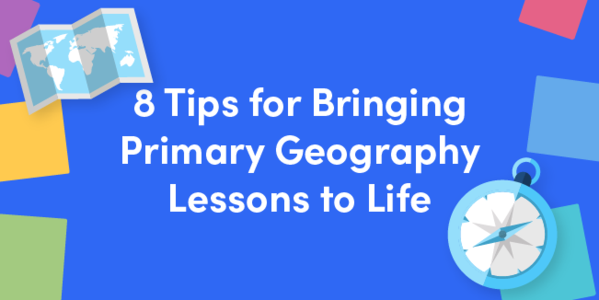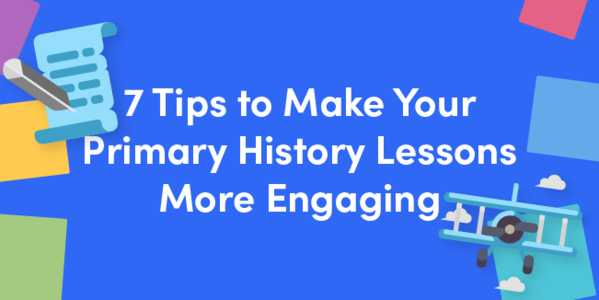8 Tips for Bringing Primary Geography Lessons to Life

Geography is a topic that can open the doors for students to become fascinated with the world around them, and geography is perhaps more relevant and necessary than ever before as we tackle climate change and other environmental issues. The problem with geography is, without the right intention behind how it is taught, it can feel dry and irrelevant to pupils.
So, how do we plan geography lessons in a way that inspires our pupils to connect with the topics they’re studying? Here are 8 tips for bringing Primary geography lessons to life:
8 Tips for Bringing Primary Geography Lessons to Life
1. Allow pupils to become investigators
Listening to lectures on a topic can be difficult for university students to engage with, so primary school children are going to find it almost impossible to engage with information they’re simply being told, even if videos and documentaries are used.
Instead, find ways to allow children to take an enquiry-based approach to their learning, where they are posed a geographical problem and asked to find a solution. This approach moves pupils from a passive role to an active one, even if they’re still sitting at their desks.
For example, if you’re teaching KS1 Hot and Cold Places, consider splitting the class into groups and asking them to investigate an animal and the temperate environment it lives in. This doesn’t have to be complicated research but could instead involve asking the class to come up with 5 animals that like the cold and 5 that like the warm or getting the class to think about their pets and the time of environment they’re adapted to. This way, you're ensuring your Geography lesson plans have an interactive element that keeps pupils engaged.
2. Adapt to the local area
Discussing global issues is often too abstract for pupils to grasp, so bring things down to the local level and work with the local geography around the school. Whether you’re in a coastal area, city centre, or close to wind farms, what surrounds your school can help pupils understand the real-world significance and consequences of what they’re learning about.
For KS1, key geographical skills can be taught through the module Know my Local Area. Think about using the school's address for introducing younger years and KS1 to the concepts of addresses and postcodes, or use a local map to introduce the basic concepts of mapping.
You can use the area around the school for fieldwork, too. Plenty of data can be gathered and theory put into practice in the playground or just a short walk from the school. If you’re teaching a KS2 module on rivers, a simple trip out to the local river will allow you to show students how the currents move, discuss where all the water came from, and even how humans have used the rivers for energy, trade and transport, and drinking water in the past.
3. Work with personal geographies
In addition to working with the local geography, you can also ask pupils to engage with other areas they’ve travelled to. Whether they’ve travelled halfway across the world or have never been more than 50 miles away, you can use these experiences to put your lessons into a new, more personal perspective.
4. Speak to current events
It’s necessary to look into the past to forecast the future, but that doesn’t mean that your pupils should always be working with historical data. Current data, i.e. within their lifetime, will feel much more relatable and real to them. Refresh your case studies from year to year so that more recent examples of geographical events can be used and the effects they had on the communities they affected feel more relevant. Focus Education do this effectively in their Primary Geography scheme of work. They provide clear guidance and example case studies but include prompts to encourage you to use local and more recent examples.
You can then relate these events to more dramatic historical events if desired, and they’ll have more relevance because your pupils will have a more recent (and thus relatable) steppingstone to understand what happened in the past.
5. Use the past
We’ve just touched on the importance of making geography current for pupils, but don’t forget how intriguing a shot into the past can be. Historical maps and photos of the area show pupils how their local landscape has changed over time, for better or worse. For example, an old picture of a shoreline or cliff can demonstrate erosion, and old photos and maps of the local area will show how land use has changed over time. A combination of both past and present in your Primary Geography lesson plans can help pupils understand how Geographies have changed over time.
5. Make it real-world
Wherever possible, relate what your pupils are learning back to the real world, either by relating the topic to something they do every day (such as using water) or by getting pupils on their feet and doing activities. For example, why not create a set of instructions KS1 pupils can use in small groups (or individually) to navigate around the classroom or playground to find hidden treasure using a compass? A quick demonstration of a compass feature on a phone will also encourage students to think about how a skill like using a compass could be used in the real world.
6. Empower your pupils
There’s never been a time when we’ve needed to be more aware of the impact we have on the planet and what we need to do on a personal level to affect change. Many of the things we can do can be done by young pupils too, such as recycling, making eco-friendly swaps, or walking or cycling to school instead of getting in the car. While not all parents will thank you for it, the planet will, and pupils will feel empowered to make decisions that affect the world.
Earth Cubs have some lovely EYFS resources for raising awareness of Geography and the environment. For example, this transport game encourages the use of more environmentally-friendly transport and this presentation gets children thinking about the impact of Plastic Pollution.
7. Be creative
Mix up your geography lessons so they don’t always have the same format - watch videos in one, make leaflets in the next, and head outside in the one after that. Make sure your pupils are excited to see what they’re going to do next. Here are some other ideas you can use as inspiration:
- Create maps of an event that happened to them (such as a visit to a zoo or moving from one county to another) or an autobiographical map of their life so far
- Create maps of fantasy worlds from books, TV shows, and movies they adore
- Consider how a real-world problem may affect a beloved fantasy world
- Map where in the world their family’s food comes from (Kiwis from New Zealand, for example)
- Map where their most distant relatives live
- Use Google Maps or Google Earth and challenge your students to find a certain feature
- Try playing with GeoGuessr as a class to guess where in the world a location is (they have options to narrow it down to certain localities)
Make Geography Lesson Planning Easier
We know putting this into practice can take a lot of work and lesson planning, but we’re here to help you create fun and engaging geography lessons without a huge time investment. Our new geography partner Focus Education makes it possible for you to teach the national curriculum in a way that’s bespoke to your class, creating lessons that encourage local links and show children how the knowledge they’re learning impacts the world around them.
Focus Education has created a Years 1-6 progressive Geography scheme of work that provides clear guidance and structure to ensure teachers adhere to the National Curriculum, whilst encouraging teachers to make local links. This ensures your pupils are taught a bespoke and engaging Geography curriculum, without the time and resource efforts of creating a scheme from scratch.
You can find Focus Education’s Geography, History, and Science scheme, alongside thousands of other time-saving lesson plans and resources in the Pango library. Sign-up for your free trial today!


